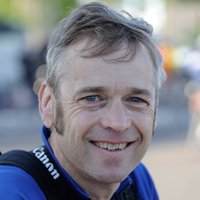"People could die."
That realization was more than enough to motivate 31-year-old Bridget Foley to roll out of bed early on a chilly, drizzly Saturday morning and take a swim in Pewaukee Lake.
It wasn’t just a cautionary measure, it was a requirement for Foley and others who made the Pewaukee Triathlon their first outing in the multi-discipline sport. Organizers of the race imposed the swim-test rule for rookies, and offered free clinics and testing in the water in the weeks before the event on Sunday.
"As far as I know, we’re the first ones in the country to do it," said Cole Braun, the race director from Great Lakes Multisport.
P3 Peak Performance Professionals organized the Saturday morning clinics and the weekly swim sessions from 5:30 to 7:30 p.m. on Monday nights.
"The most important thing is for the beginner to find out can they do this," said Bob Hanisch, a former USA Triathlon coach and head of P3.
Roughly 305 of the 1,500 participants were required to pass the swim test before taking the start line on Sunday. Nearly two dozen failed the first time. About half of them tried again, and others received a refund of the entry fees.
In addition to the test-first rule, Braun and his race team eschewed the typical mass start on Pewaukee Beach and sent competitors out in pairs, with 10-second intervals between starters. Eleven lifeguards were be deployed on the course, and police boats and the Pewaukee Lake Patrol joined the safety team.
While Braun touted Pewaukee as the first triathlon in the country to impose a swim-test rule for rookies, water safety has become a main point of emphasis for the roughly 4,300 events sanctioned by USA Triathlon each year, and for good reason.
At least four people have died swimming in triathlons in Wisconsin over the past four years, including 33-year-old Daniel Murry, who died during the 2009 Pewaukee Triathlon.
Nationally, 30 people died during the swim portion of USA Triathlon-sanctioned races from 2003-11, according to a study conducted last year by the sport’s governing body. An analysis of those deaths identified sudden cardiac arrest as the primary threat, although that conclusion is not definitive.
Preventing someone from having a heart attack in the water is seemingly impossible. Teaching swimmers to control their anxiety and prepare for the chaos of an open-waters swim was the goal of the rule implemented in Pewaukee.
Anita Krier, an instructor from Training Solutions in Pewaukee, coached the two-dozen first-timers who gathered on the beach off Wisconsin Ave. late last month. She warned the rookies to expect to be kicked and punched and disoriented off the weedy shore of Pewaukee Lake. Their strokes and their movement will be disrupted.
"Open-water swimming is a contact sport," she said. "What is my plan going to be?"
Krier encouraged the swimmers to start easy, then go easier; and to look often for land and the buoys marking the course – one-quarter mile for the sprint distance and nearly one mile for the Olympic distance.
More emphatically, she urged them to train in open water, away from the comfort of lane markings and a wall to grab in local pools.
"The more experience you have in open water, the better you’re going to feel," Krier said.
USA Triathlon lists practicing in open water as one of the safety recommendations developed from its analysis of swimming deaths, along with undergoing a medical check-up prior to the race and developing a race plan consistent with one’s training and fitness level.
Participants described Krier’s clinic and the experience in Pewaukee Lake as invaluable. They learned the water is far darker than they had anticipated, and even in a small group, they were kicked and jostled by those around them.
"The swimming certification was a huge help," said Foley, who finished sixth in her age group in the sprint distance race. "Had I not been required to take the course, it’s likely my first time swimming in open water (in about 15 years) would have been race morning.
"The certification calmed my pre-race nerves and unknowns by providing a lot of pointers that I used during the race, such as what to do when someone is swimming on or over you, how to sight land and what to do if you need a break.
"I hadn’t signed up for a tri before because of the swimming portion, but feel the certification played a huge part in making my first tri experience a great one."
Braun said he received similar positive comments from first-time triathletes. The relative safety of the race was even more rewarding.
One swimmer had to be transported to shore by boat after becoming ill in the water, and two others sought help from lifeguards after becoming exhausted in the swim.
"Logistically, it went great," Braun said. It was exactly what we wanted."
Memories of running cross-country for the Slinger Owls motivated Tom Held to get his body moving again when he turned 30. Almost two decades later, he's still on the move. The 49-year-old bikes, runs and skis, and covers news for similarly active people as a freelance writer and blogger.
He spent 26 years as a daily news reporter, and applies that experience to dig out stories about athletes, races, endurance sports, fitness and self-propelled transportation. His work has appeared in Silent Sports Magazine, Wisconsin Trails and Cross-Country Skier.
Held lives in the Bay View neighborhood, where he counts being Dad to twin daughters part of his daily workout.







